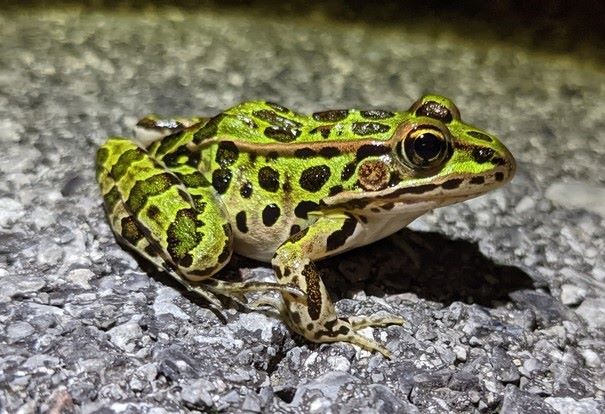What Do Northern Leopard Frogs Sound Like?
The predominant Northern Leopard Frog sound is the mating (or “advertisement”) call of the male, and takes place during its breeding season.
Northern Leopard Frog (Lithobates pipiens) calls are one of about 30 true frog calls in the United States and one of about 100 frog and toad sounds.
The mating call is made using paired vocal sacs and is often described as a “guttural snore” that typically lasts three seconds or longer. These snores start off loud and trail off toward the end. The call is followed by what some call a “chuckle” or soft grunts. The pulse rate of the call is temperature dependent. Check out an example in the video below.
When Do Northern Leopard Frogs Call?
Northern Leopard Frogs frogs breed the spring, but the exact breeding season depends on latitude. This period is typically between a week and a month long, and starts as early as March in some southern climates, and as late as mid-May farther north.
The males arrive first at breeding locations and begin frog calls begin when the water and air temperatures reach about 50°F. Females arrive between three and fourteen days after calling begins.

Calling activity decreases when air temperatures drop below 50°F, although some people have reported hearing calling close to freezing temperatures.
Northern Leopard Frog sounds (and mating) often occur during the day in the early spring, although nocturnal calling occurs as well. Males may occasionally call well after the breeding season, especially when it rains or is cloudy.
Where Do Leopard Frogs Call?
During breeding season, Leopard frogs typically stay in the same calling position and move only short distances to warmer locations. There is no territorial behavior among males.
Males Northern Leopard Frogs call while floating on the water’s surface with limbs outstretched. Occasionally, frogs may make noise outside of the water or from the bottom of a pond.
During courtship, both males and females may be approached by a male seeking to mate. Males that are grasped by other males will give a release croak that causes the mistaken male to let him go.
References
This sound guide draws from several sources, including several AmphibiaWeb and Animal Diversity Web, The Frogs and Toads of North America (2009) by Elliott, Gerhardt, and Davidson and Frogs and Toads of the United States and Canada (2013), by C. Kenneth Dodd.
